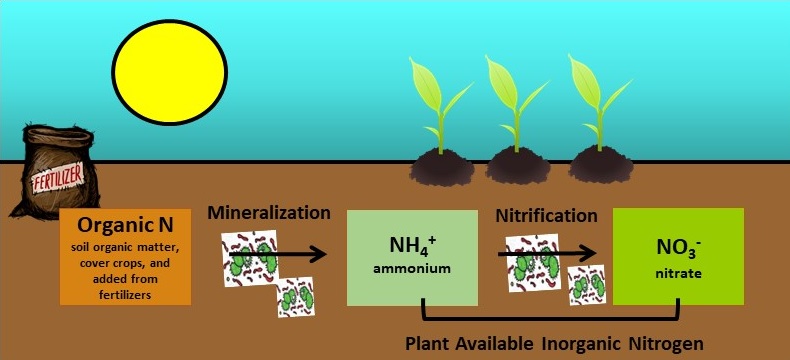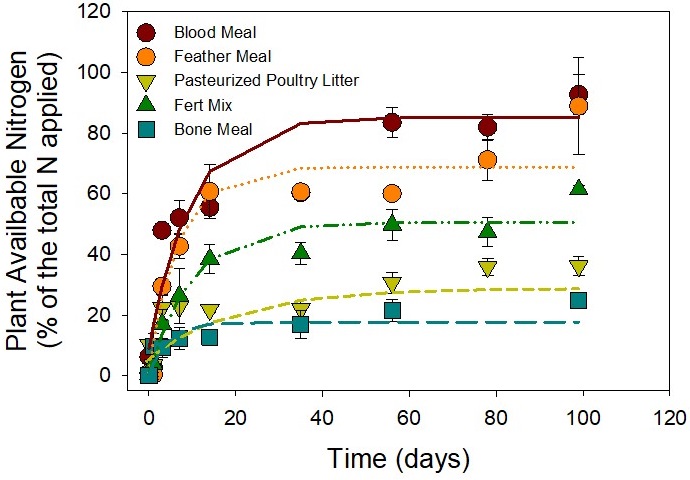ORGANIC FERTILIZERS NITROGEN AVAILABILITY CALCULATOR FOR IRRIGATED FIELDS
Welcome
Organic and sustainable producers rely on cover crops, soil organic matter, composts, manures, and the addition of fertilizers to supply important plant nutrients for good plant health and maximum yield. Similar to conventional fertilizers, fertilizer grades (N-P2O5-K2O) are listed on organic fertilizer bags and can be determined for manures, but these organic products are very different from their inorganic fertilizer counterparts. As their name would suggest, nutrients in organic fertilizers are in their organic form, meaning they must be transformed by microorganisms in the soil before becoming plant available inorganic forms. For organic fertilizers, how much and when the nitrogen will actually become plant available is dependent on the particular fertilizer and the conditions in the field at the time of application. Please check out our Research Tab in the red bar above for more information on nitrogen availability, the development of the calculator, and helpful resources.
What to Expect from the Organic Fertilizers Nitrogen Availability Calculator
This calculator will predict how much and when nitrogen will be plant available from applied organic fertilizers and poultry litters by predicting nitrogen mineralization for irrigated fields. The calculator takes into account the initial inorganic nitrogen in the material (what's immediately available), individual rates of mineralization, and the soil temperature (5-year averages) from the closest weather station to predict plant available nitrogen over the season. Additionally, the calculator will provide the TOTAL amounts of nitrogen (N), phosphorus (P), and potassium (K) that was applied with the fertilizers used. This does NOT necessarily mean that these amounts are all plant available but it will help avoid over-applications. Results are given on a pound-per-acre basis.
Instructions
Click the calculator tab located in the red bar above to start. You will be led through questions about your farm location (for weather data), farming practices, and fertilizer applications.
Contact
For questions about how to use the calculator, contact your local County Extension Agent.
Calculator
Please answer the questions below and click "Next Page" when complete.
Background
| To choose the closest weather station, what county is your farm located in? (OR Choose from interactive map.) | |
| What is the crop? | |
| What is the planting date? | mm/dd/yyyy |
| What are the estimated days to harvest? | |
| What is your target nitrogen rate (lbs N/acre)?
(See crop recommendation sheet for specific crops if unknown here.) | lbs N/acre |
| Please enter your nitrogen credit for our cover crop calculator or an estimate from our bulletin. | lbs N/acre |
Please answer the questions below and click "Next Page" when complete.
Your Organic Fertilizer
| Choose an ORGANIC fertilizer
Choose OTHER if not on the list. | |
| What is the grade of your fertilizer? | - - N-P2O5-K2O |
| Application Rate? | |
| Date Applied? | mm/dd/yyyy |
| Do you apply a SECOND ORGANIC fertilizer? | |
Choose OTHER if not on the list. | |
| What is the grade of your fertilizer? | - - N-P2O5-K2O |
| Application Rate? | |
| Date Applied? | mm/dd/yyyy |
| Do you apply a THIRD ORGANIC fertilizer? | |
Choose OTHER if not on the list. | |
| What is the grade of your fertilizer? | - - N-P2O5-K2O |
| Application Rate? | |
| Date Applied? | mm/dd/yyyy |
Please answer the questions below and click "Next Page" when complete.
Your Poultry Litter Application
| Do you apply POULTRY LITTER? | |
| What is the grade of your fertilizer?
(If unknown, the program will use typical values found in poultry litter.) | - - N-P2O5-K2O |
| Application Rate? | |
| Date Applied? | mm/dd/yyyy |
| Was it incorporated? | |
Please answer the questions below and click "Next Page" when complete.
Your Inorganic Fertilizer
|
Do you apply INORGANIC fertilizer?
Examples include Chilean Nitrate (NaNO3), rock phosphate, sulfate of potash. | |
| What is the grade of your fertilizer? | - - N-P2O5-K2O |
| Application Rate? | |
| Date Applied? | mm/dd/yyyy |
| Do you apply a SECOND INORGANIC fertilizer? | |
| What is the grade of your fertilizer? | - - N-P2O5-K2O |
| Application Rate? | |
| Date Applied? | mm/dd/yyyy |
| Do you apply a THIRD INORGANIC fertilizer? | |
| What is the grade of your fertilizer? | - - N-P2O5-K2O |
| Application Rate? | |
| Date Applied? | mm/dd/yyyy |
Is this information Correct? If not, click a data point to edit it.
Organic and Poultry Fertilizer Calculations
| Fertilizer | Applied (lbs/A) | Water Content (WC) | Total N | Pool of mineralizable N (N0) | Rate constant of mineralization (k) | Initial Inorganic N g N/kg |
|---|
Inorganic Fertilizer Calculations
| Fertilizer | Applied N (lbs/A) |
|---|
Constants for this site
| Bulk Density (BD) | 1.5 |
| Drained Upper Limit (DUL) | |
| Drained Upper Limit / BD | |
| Air Dry (AD) | |
| Air Dry / BD | |
| Saturation water content (g/g) (Sat) |
Daily data
| Weather Station Data | ||||||||
|---|---|---|---|---|---|---|---|---|
| Day | Temperature °C | Moisture % | Sw | Temperature Factor (TFac) | Moisture Factor (MFac) | |||
TOTAL NUTRIENTS APPLIEDThis table represents the TOTAL amount of nutrients applied to your plot, not necessarily what is plant available (see the Instructions and Research tabs for details). Organic fertilizers and materials must undergo mineralization to become plant available (below). |
|
PLANT AVAILABLE NITROGENBased on your fertilizer selection and the predicted weather on your field, pounds of N will become plant available from the time of application to your selected date. This graph will give you an idea about when the N will be released and your target N goal. To determine how much available N is available at a given time, follow the vertical line up from the date to the plotted curve. Each N fertilizer is shown as well as the cumulative N release from the combination of fertilizer products. This graph may help you adjust your N fertilizer at planting or at side dress. |
Understanding Nitrogen Availability from Organic Sources
Organic fertilizers are derived from a wide variety of products. These products (such as feather meal, poultry manure, or vegetable matter) can range from 3 to 15% total nitrogen. Unlike inorganic fertilizers (example Chilean nitrate or ammonium nitrate), the nitrogen in organic products is tied up in organic forms (such as amino acids or proteins) that is not immediately available for plant uptake. Organic nitrogen must be degraded by microorganisms in the soil to become plant available inorganic ammonium and nitrate through processes called mineralization and nitrification. How much and when this inorganic N will be available depends on the fertilizer or organic material used and the weather conditions after application. The more complex the organic nitrogen molecule, the more difficult it is to degrade and with mineralization and nitrification dependent on soil microorganisms, the soil temperature and water content determine the health of microbial communities and the rate of decomposition.
Because the rate of available nitrogen from organic sources is dependent on many variables, it is difficult to synchronize plant-available N release with plant need. Too much N too soon, could lead to nitrogen runoff/leaching, increased pest and disease pressure, or decreased fruiting. Too little N could lead to poor plant health and reduced yield. Either scenario leads to a loss of profits. Matching plant uptake with available nitrogen is important to maximizing yields, reducing costs, and reducing the potential for environmental degradation.

How the calculator was developed
This calculator was funded by a Southern Sustainable Agriculture Research and Education (SSARE) grant and was developed using studies conducted in the lab, on research farms, and on private farms from participating farmers.
Lab Studies
Lab studies were conducted to determine how much nitrogen would mineralize from organic fertilizers, poultry manure, and composts under "ideal conditions". These ideal conditions (85°F and water content near field capacity) should maximize microbial activity and give estimates of the maximum amount of nitrogen that becomes available from these materials. For our lab studies, we looked at 24 different organic fertilizers, 15 different poultry litters, and 11 different composts to determine the rate and total amount of nitrogen availability. For the organic fertilizers, plant available nitrogen released over 100 days ranged from 25 to 93% of the applied nitrogen. Plant available nitrogen release from poultry litters ranged from 25 to 56% of the total nitrogen. For the composts, many of the materials showed immobilization (net tie up of nitrogen) or very low nitrogen availability (4% of the applied nitrogen). Immobilization occurs when the microorganisms decomposing the material tie up some of the nitrogen, thereby reducing availability to plants. While compost is a great soil amendment that can provide other nutrients and stimulate soil health, it does not provide much as a nitrogen fertilizer and (in general) should not be considered in the nitrogen budget. Below is an example of the pattern of release for some of fertilizers studied for the calculator.

Field Studies
To determine how soil water content and temperature affect plant available nitrogen from these materials, field studies were conducted during summer and fall seasons. Studies were carried out at the University of Georgia Durham Horticulture Farm and at four private farms from participating farmers located in the Georgia Piedmont. These studies were used to test the calculator under real world conditions with fluctuating temperatures and soil water contents. Participating farmers chose their own fertilizer and fertilizer application rates to demonstrate differences between practices.
Helpful Publications and Resources
UGA Extension Fertilizer Calculator
http://aesl.ces.uga.edu/soil/fertcalc
UGA Extension Nitrogen Availability Calculator for Cover Crops
http://aesl.ces.uga.edu/mineralization
Crop Recommendations from AESL
http://aesl.ces.uga.edu/publications/soil/CropSheets.pdf
Sustainable Agriculture at UGA: Organic Production
https://sustainagga.caes.uga.edu/systems/organic-production.html
Southern SARE
https://www.southernsare.org/
University of California UC Davis Crop Uptake of Nitrogen
https://apps1.cdfa.ca.gov/FertilizerResearch/docs/N_Uptake.html


